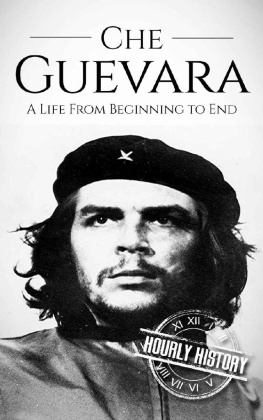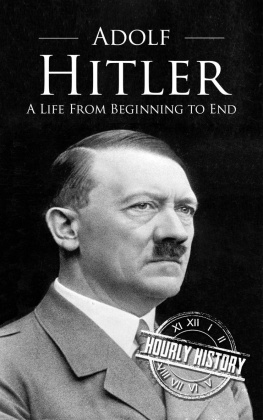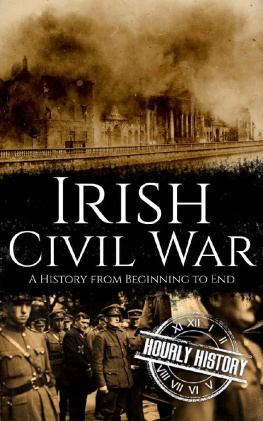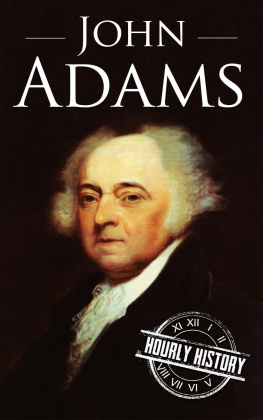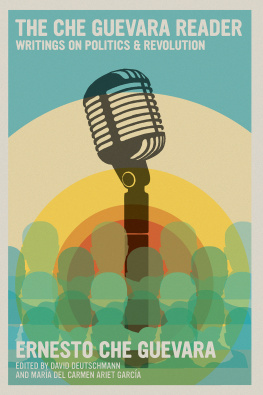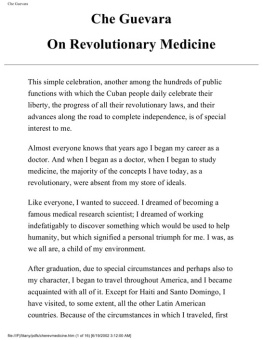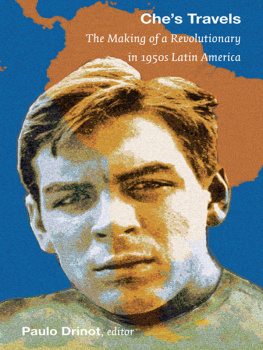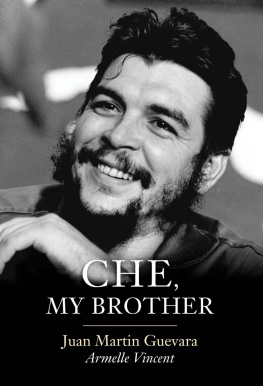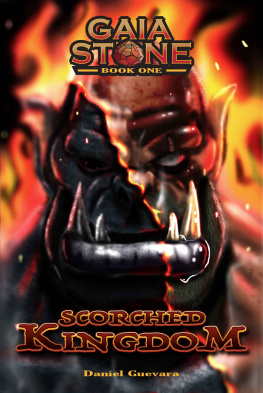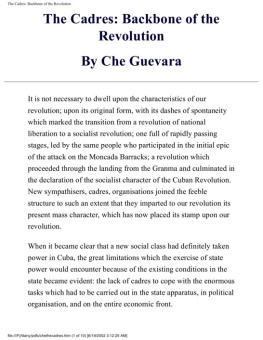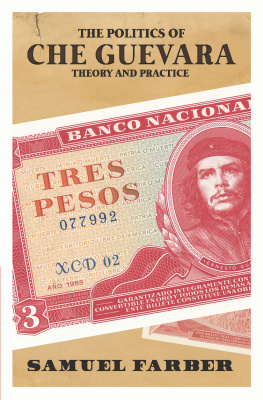CHE GUEVARA
A Life From Beginning to End
Series Information: Revolutionaries Book 2
Copyright 2016 by Hourly History.
All rights reserved.
Table of Contents
Introduction
Che Guevara was born on June 14th, 1928 to a fairly privileged family in Rosario, Argentina. Before he became Che the revolutionary, he was known as Ernesto Guevara, the oldest son of an average middle-class family in Latin America. Despite being born into a fairly status quo family, Ernesto Che Guevara always lent his ear to those who had less than him in life.
Ever curious about the world around him and its political and social systems, by the age of 14 he became a voracious reader, taking to heart the ideas of Marx, Engels, and even Sigmund Freud in his early philosophical attempts at understanding the social order around him. These books sparked a desire in the young Ernesto not only to understand the ills of society but also a drive to find ways that he himself could alleviate social distress.
In 1951, when he was a 22-year-old pre-med student, Che took a year off so that he could ride his motorcycle on a 5000-mile cross-continental trek across South America to view some of the poorest parts of the land first hand. One of the most striking moments of his odyssey was when he came upon a leper colony in the town of San Pablo in Peru.
This colony of lepers, having been ostracized from the greater Peruvian community, had become completely self-sufficient and had developed their own closely-knit society amongst themselves. Upon investigating these outcasts further Che was greatly impressed with what he called their human solidarity, which had risen up out of what he had termed the most lonely and desperate of conditions.
In other words, he was amazed at the humanity that had come out of these sickly men as a direct result of the inhumanity of the larger society that had shunned them. As for the lepers perception of Che, it is said that they were amazed that the young Guevara would treat them as anything other than objects of scorn and revulsion.
The only thing that did fill Che with revulsion was the way that these men were being treated; the only thing that had earned his scorn was the society that had failed them. Many point to Ches visit to the leper colony as the seminal event in his life that sparked his interest in revolution.
Though Che would eventually finish his medical training, he would never again be satisfied just to work in a hospital. Even though Che Guevara wished to treat the sick, it was no longer the sickness of the individual body he sought to cure; his main interest was curing the sickness of society.
Chapter One
The Minds of Revolution
Revolution is not an apple that falls when it is ripe. You have to make it fall.
Ernesto Che Guevara
After his graduation from the University of Buenos Aires in June of 1953, Che Guevara left on another sightseeing trip that took him once again to Peru, then all the way to El Salvador, before finally settling in Guatemala in early 1954. When Che arrived on the scene the recently elected president of Guatemala, Jacobo Arbenzonly the second democratically-elected president of the countrywas initializing an ambitious land reform effort.
Arbenz sought to end the latifundia or traditional land system of Latin America by redistributing land from the rich elite to the poor, including giant swathes of land from the biggest corporation in the region, the United Fruit Company. It was the latter that would eventually bring the ire of the United States. It was an ill sentiment that was much inflamed by a paid public relations specialist from the United Fruit Company who lobbied the U.S. for support against what it described as a communist take over.
Even though no communist sentiment at that time was forthright, the fearful anti-communist climate of the Cold War era soon led the administration of Dwight D. Eisenhower to make suppressing the government of Jacobo Argenz one of his main objectives. However, even while bells of alarm were ringing in the Pentagon, the concerted efforts of Jacobo Arbenz to uplift the poor and struggling were music to the ears of the socially conscious Che Guevara; soon he was happy to call Guatemala his new home.
Settling into his new life in Guatemala City, Che soon found a companion to share his idealistic vision with, the woman who would become his first wife: Hilda Gadea Acosta. Hilda was living in exile at the time, having been pushed out of her native Peru in 1948 for her own alleged communist activity.
Exile did not stop her political activism, however, and when Che first met Hilda she was busy organizing for the left wing group Alianza Popular Revolucionaria Americana (American Popular Revolutionary Alliance). It was through Hilda that Che would receive his first line of contact to another budding young revolutionary who hailed from the other side of the Gulf: Fidel Castro.
Che Guevara would later describe his introduction to the Cuban dissident Fidel Castro as nothing short of transformative. Che described it as being, A political event was that I met Fidel Castro, the Cuban revolutionary. He is a young intelligent guy, very sure of himself and extraordinarily audacious; I think we hit if off well. It was in this cadre of exiled revolutionaries in Guatemala that Che Guevara had finally found his niche and began to shape and refine his mindset and worldview to match it.
This was also where he developed a firm disdain for the interferences and entanglements of the United States. Disdain that would be enhanced by the American CIA-engineered and led coup against the Guatemalan president that eventually forced him to resign. The reasoning behind the efforts of the CIA was complex and multifaceted. Many claim it was out of fear of the communist leanings that were already beginning to surface in Arbenzs regime, while others have pointed their fingers elsewhere.
Regardless of the reasoning behind it, from Ches perspective, all he saw was a domineering, imperialist power, seeking to destroy a Latin American democracy for its own interest. Because of U.S. interference, he saw all of the reforms that he viewed as great improvements in the lives of the ordinary citizen go up in smoke, just because the dominant power to the North decided it didnt like their policy and wanted to meddle in Guatemalas affairs.
And even though President Arbenz had fled and his government had collapsed, Che was not ready to give up, and joining an underground militia, he vowed to fight on. His fervor to support the quashed democracy of Guatemala soon found him on the radar of those who had led the coup, and his future wife Hilda was arrested. Che, fearing arrest himself, then found refuge inside the Argentinean embassy, staying inside the building until he was guaranteed safe passage to Mexico on September 21st, 1954. His wife would follow him as soon as she was released.
Mexico loomed large in Ches mind as a beacon of resistance against imperialism, since Mexico bordered the United States, andas Che Guevara perceived itwas on the frontlines in his war against capitalist domination. It was during his sojourn in Mexico that Che Guevara met Fidel Castros brother Raul, who had just been released from prison for his role in resistance to the Guatemalan coup, and it was Raul who would eventually arrange an in-person introduction between Che and Fidel Castro, forever enshrining Mexico City as the place where the minds of revolution met.
Chapter Two
The Proudest Man in the World
We cannot be sure of having something to live for unless we are willing to die for it.

